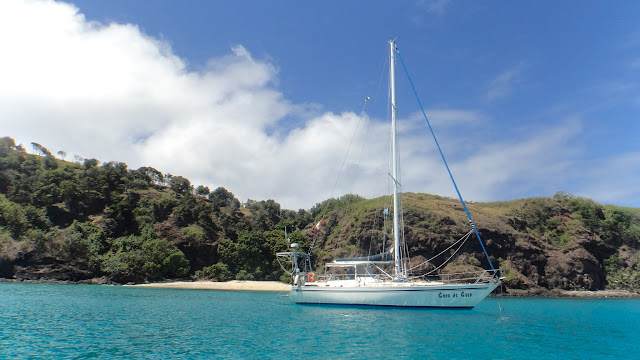The Great Astrolabe Reef
We left Matuku before sunset. Once we were outside of the
reef, we raised the genoa (head sail). It was very rolly, overcast, rainy and
cool. The wind was much stronger than predicted and we were a bit concerned
about waves breaking over the stern of the boat. We hoped it would calm down
once we were further from the island. The waves did settle into a pattern, but
were still very large. A small pod of dolphins joined us until the sun was
gone. The boat sailed very well, maybe too well, as we once again were going to
arrive at the entrance to Astrolabe Reef earlier than planned. Throughout the
night, especially during Dina’s watches, the boat was doing 10-11 knots and she
saw 14.6 at one point!
Although we tried to dump wind and slow down, we arrived 4
hours earlier than expected (3 hours before sunrise). We still had lots of
wind, but a least the water was calmer because we were downwind of the reef. We
gybed back and forth outside the pass for a few hours until we had enough light
to see, entered the reef at Usborne Pass and anchored off Dravuni Island. The Chief was away working at a nearby resort (we later
learned the village had negotiated with the Australian resort owners that they
could use the land as long as they employed the locals at the resort). We did sevusevu
with the local Mayor, Isaac. Once we were welcomed, we walked almost all the
way around the island.
We met the local Chair of the Village Tourism Committee, Marika.
He explained to us that the village had negotiated with Holland America cruise
lines to stop at Dravuni Island. Apart from the main island of Fiji, Dravuni is
the only other island that receives cruise ships. The village is notified
before the ship’s arrival and the locals ready the dock, the beach massage huts
and tables, the traditional dance area and craft stalls. It is a very organised
island. We stayed for another day, had more fresh coconut and another walk on
the beach. It was a lovely place to spend some time while waiting for our
friends on SV Free Spirit and SV Roxanne to catch up to us.
 |
| Yaukuelailai island anchorage |
Before our friends showed up, we motored just a few nautical miles south to Yaukuelailai Island. It was a lovely secluded island with secluded beaches and wonderful snorkelling right from the boat. The first day the snorkelling was great, but the next day, after the morning rain, we encountered swarms of tiny, clear, jelly fish. They did not sting, but there were so many, it was impossible to see anything!
 |
| LOTS of Jellyfish, plus a leaf |
After four nights in beautiful seclusion, we motored less than an hour south to Vurolevu Island. We snorkelled in the bay and explored a couple of beaches while Tom and Lynn, on SV Roxanne, arrived. We had not seen them since Tonga, almost a year before, so it was a wonderful reunion. Chuck and Lauri, on SV Free Spirit, arrived the next day and we all dinghied over to the NE point where we had heard that manta rays are often seen. We swam with three mantas – one was very large with no tail, another was large with a tear in its flap and a third was smaller (younger?). The six of us all swam with them until we were too cold or too tired to keep up with them.
We wanted to dive the famous Naigoro Pass in the Astrolabe
Reef, so we motored around to Naigoro Bay in the rain and cold. The next day,
Gerald, from Matava Resort, picked us up, along with Tom from SV Roxanne, to
dive. There was an out-going current in the pass, which we thought was not good
for diving, but the guides returned from a scouting swim and said all was fine.
Dina was having trouble with her buoyancy and mask, so one
guide took her back up to the boat a few minutes before the others were
finished. The current seemed to get stronger and just before the dive ended,
Malcolm and another guide were swept around a corner of the reef and out into
the active pass. With the other divers and guides on the dive boat, everyone
was looking for Malcolm and the guide. The waves were now so high, it was
difficult to see them and the dive boat was having trouble manoeuvring. After
15-20 minutes, Tom said, “There they are!” It still took the dive boat a while
to reach them. A rope with a float was tossed out, but the current was so
strong, the rope burned Malcolm’s hands and then snapped. The dive boat circled
again and tossed another line and this time Malcolm and the guide made it
aboard.
 |
| Wall dive at Naigoro Pass |
After a rest and some snacks, we went to a shallower, inner
reef (not out the passage) called, Ozzi Reef. The sun was trying to come out
and as this was not as deep, it appeared more colourful. We all thought it was
better than the Naigoro Pass.
